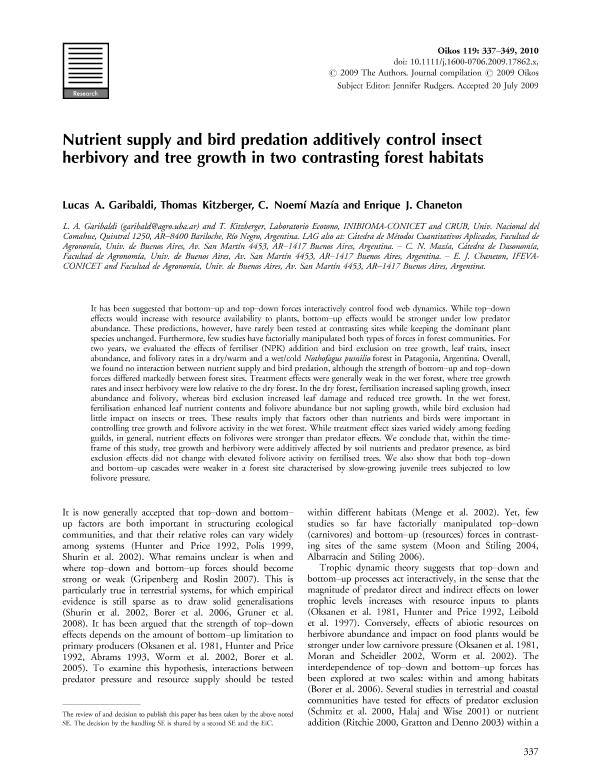Artículo
Nutrient supply and bird predation additively control insect herbivory and tree growth in two contrasting forests. Oikos
Fecha de publicación:
02/2010
Editorial:
Wiley Blackwell Publishing, Inc
Revista:
Oikos
ISSN:
0030-1299
Idioma:
Inglés
Tipo de recurso:
Artículo publicado
Clasificación temática:
Resumen
It has been suggested that bottom-up and top-down forces interactively control food web dynamics. While top-down effects would increase with resource availability to plants, bottom-up effects would be stronger under low predator abundance. These predictions, however, have rarely been tested at contrasting sites while keeping the dominant plant species unchanged. Furthermore, few studies have factorially manipulated both types of forces in forest communities. For two years, we evaluated the effects of fertiliser (NPK) addition and bird exclusion on tree growth, leaf traits, insect abundance, and folivory rates in a dry/warm and a wet/cold Nothofagus pumilio forest in Patagonia, Argentina. Overall, we found no interaction between nutrient supply and bird predation, although the strength of bottom-up and top-down forces differed markedly between forest sites. Treatment effects were generally weak in the wet forest, where tree growth rates and insect herbivory were low relative to the dry forest. In the dry forest, fertilisation increased sapling growth, insect abundance and folivory, whereas bird exclusion increased leaf damage and reduced tree growth. In the wet forest, fertilisation enhanced leaf nutrient contents and folivore abundance but not sapling growth, while bird exclusion had little impact on insects or trees. These results imply that factors other than nutrients and birds were important in controlling tree growth and folivore activity in the wet forest. While treatment effect sizes varied widely among feeding guilds, in general, nutrient effects on folivores were stronger than predator effects. We conclude that, within the time-frame of this study, tree growth and herbivory were additively affected by soil nutrients and predator presence, as bird exclusion effects did not change with elevated folivore activity on fertilised trees. We also show that both top-down and bottom-up cascades were weaker in a forest site characterised by slow-growing juvenile trees subjected to low folivore pressure. © 2009 The Authors.
Palabras clave:
Herbivory
,
Nutrients Adittion
,
Forests
Archivos asociados
Licencia
Identificadores
Colecciones
Articulos(IFEVA)
Articulos de INST.D/INV.FISIOLOGICAS Y ECO.VINCULADAS A L/AGRIC
Articulos de INST.D/INV.FISIOLOGICAS Y ECO.VINCULADAS A L/AGRIC
Articulos(INIBIOMA)
Articulos de INST. DE INVEST.EN BIODIVERSIDAD Y MEDIOAMBIENTE
Articulos de INST. DE INVEST.EN BIODIVERSIDAD Y MEDIOAMBIENTE
Citación
Garibaldi, Lucas Alejandro; Kitzberger, Thomas; Mazía, Cristina Noemí; Chaneton, Enrique Jose; Nutrient supply and bird predation additively control insect herbivory and tree growth in two contrasting forests. Oikos; Wiley Blackwell Publishing, Inc; Oikos; 119; 2; 2-2010; 337-349
Compartir
Altmétricas




